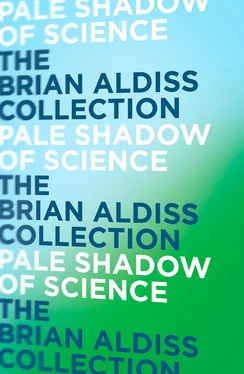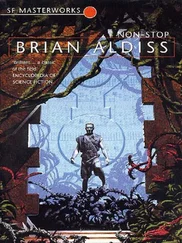Brian Aldiss - Pale Shadow of Science
Здесь есть возможность читать онлайн «Brian Aldiss - Pale Shadow of Science» — ознакомительный отрывок электронной книги совершенно бесплатно, а после прочтения отрывка купить полную версию. В некоторых случаях можно слушать аудио, скачать через торрент в формате fb2 и присутствует краткое содержание. Жанр: unrecognised, на английском языке. Описание произведения, (предисловие) а так же отзывы посетителей доступны на портале библиотеки ЛибКат.
- Название:Pale Shadow of Science
- Автор:
- Жанр:
- Год:неизвестен
- ISBN:нет данных
- Рейтинг книги:5 / 5. Голосов: 1
-
Избранное:Добавить в избранное
- Отзывы:
-
Ваша оценка:
- 100
- 1
- 2
- 3
- 4
- 5
Pale Shadow of Science: краткое содержание, описание и аннотация
Предлагаем к чтению аннотацию, описание, краткое содержание или предисловие (зависит от того, что написал сам автор книги «Pale Shadow of Science»). Если вы не нашли необходимую информацию о книге — напишите в комментариях, мы постараемся отыскать её.
Pale Shadow of Science — читать онлайн ознакомительный отрывок
Ниже представлен текст книги, разбитый по страницам. Система сохранения места последней прочитанной страницы, позволяет с удобством читать онлайн бесплатно книгу «Pale Shadow of Science», без необходимости каждый раз заново искать на чём Вы остановились. Поставьте закладку, и сможете в любой момент перейти на страницу, на которой закончили чтение.
Интервал:
Закладка:
As she removed her apron, she looked up the stairwell and spoke his name. ‘Bill?’
No response, although she still heard the footsteps. It was dark up there.
‘Bill. Is that you? Are you there?’
The footsteps came out on to the upper landing.
‘Bill? Who is it? Who’s there?’
The footsteps began to descend the stairs.
She stood petrified as they passed by her eyes. Still descending. She could not leave the stairwell. The footsteps came down to hall level. They turned and came towards her.
It was then that she found the power to scream. She dropped her apron and rushed out of the front door into the lane. There she stood, as it grew dark, and waited for half an hour before my father returned. He had to coax her into the house.
‘If Bessie’s coming downstairs, I’m leaving,’ said my mother.
We sold the house. Nobody selling property mentions the fact that it is haunted. Ghosts do not increase the saleable value. We left Withburga, and shortly after that came the family row which exiled us from Norfolk forever.
Mrs Skinner and her ladies listened to the story with intense interest, peering at me through the hatch.
Immediately I had finished, they burst into excited talk. ‘There you are, what did I tell you?’ ‘So Old Bessie’s still about then ….’
Each of them had a tale to tell. They had heard spooky noises. One of them had had to come back at night and had been too frozen with fear to go in. Another had heard footsteps which seemed to walk through the cubicles upstairs. The girl at the hatch, not to be outdone, said, ‘And when you come in of a morning, there’s always – oh, you know, a kind of sinister something … I’ve never liked working here.’
Mrs Skinner told me that she had come back one evening after the offices were closed to do some work for her boss. She had gone upstairs to his room – the very room where Bessie had died – and was working there when she heard someone downstairs. Thinking it must be her boss, she had called out. No answer. When the steps began to come up the staircase, she grew alarmed and went to see who it was. The footsteps kept coming. She saw no one. She represented herself as a lady not easily upset – and indeed I believed it – but she had been so frightened that she had run downstairs and out into the lane, where she had waited until her boss arrived.
As she finished speaking, Mrs Skinner and I both realized at the same time the congruence between her story and my mother’s. We stared at each other.
And as we stared, I saw her expression change from one of a kind of quizzical amusement to one approaching fear. Her lips parted. She could not cease staring through the hatch at me.
Perturbed myself, I said, ‘I must disappear … go and join the funeral party.’
I shut the hatch. I stood there alone. The corridor was chill and empty; its hostility closed in upon me.
As I hurried down the corridor into the open, as I left Withburga, as I moved rapidly down the lane, I knew exactly what the expresion on Mrs Skinner’s face implied. She had become, in that instant, certain that she was talking to the ghost itself.
Back at the hotel, our party was ordering its second round of gin-and-tonics.
‘Bessie’s still in residence,’ I told my sister. Even as I said it, a thought occurred to me which I will leave with you. It had been our asssumption that the haunter of Withburga was Old Bessie. But we could have been wrong. The tormented spirit which still wandered in its imprisoned limbo was possibly much older than Bessie – older and more malevolent.
Is this a true story? I don’t know. I still cannot bring myself intellectually to believe in ghosts.
This second section consists of articles on major contributors to the SF field whose work I admire greatly .
They run as follows: Mary Shelley , to whom all SF writers owe a debt , Olaf Stapledon , George Orwell, Phillip K . Dick , James Blish , and Harry Harrison .
Science Fiction’s Mother Figure Science Fiction’s Mother Figure The Immanent Will Returns The Downward Journey: Orwell’s 1984 A Whole New Can of Worms Peep A Transatlantic Harrison, Yippee! The Atheist’s Tragedy Revisited The Pale Shadow of Science A Monster for All Seasons Helliconia: How and Why Bold Towers, Shadowed Streets … … And the Lurid Glare of the Comet When the Future Had to Stop What Happens Next? Grounded in Stellar Art It Takes Two to Tango Robert Sheckley’s World: Australia Sturgeon: Mercury Plus X The Glass Forest About the Author Also available by the author Also part of The Brian Aldiss Collection Copyright Конец ознакомительного фрагмента. Текст предоставлен ООО «ЛитРес». Прочитайте эту книгу целиком, купив полную легальную версию на ЛитРес. Безопасно оплатить книгу можно банковской картой Visa, MasterCard, Maestro, со счета мобильного телефона, с платежного терминала, в салоне МТС или Связной, через PayPal, WebMoney, Яндекс.Деньги, QIWI Кошелек, бонусными картами или другим удобным Вам способом. About the Publisher
IN ANTHONY BURGESS’S NOVEL, BEARD’S ROMAN WOMEN (1977), there is a passage where Beard, the central character, meets an old girl friend in an airport bar. Both work in what it is fashionable to call ‘the media’; they discuss Byron and Shelley, and she says ‘I did an overseas radio thing on Mary Shelley. She and her mother are very popular these days. With the forces of women’s liberation, that is. It took a woman to make a Frankenstein monster. Evil, cancer, corruption, pollution, the lot. She was the only one of the lot of them who knew about life ….’
Even today, when our diet is the unlikely, Mary Shelley’s Frankenstein seems extremely far-fetched; how much more so must it have appeared on publication in 1818. Yet Beard’s girl friend puts her finger on one of the contradictions which possibly explains the continued fascination of Frankenstein , that it seems to know a lot about life, whilst being preoccupied with death.
This preoccupation was undoubtedly an important strand in the character of the author of Frankenstein . Marked by the death of her mother in childbirth, she was haunted, at the time of writing Franken stein, by precognitive dreads concerning the future deaths of her husband and children. By embodying some of this psychic material into her complex narrative, she created what many regard as that creature with a life of its own, the first SF novel.
This perception will bear examination later. Meanwhile, it should be pointed out that Frankenstein is generically ambivalent, hovering between novel, Gothic, and science fiction, just as its science hovers between alchemy and orthodox science. To my mind, precisely similar factors obtain even today in the most celebrated SF novels. Heinlein’s Stranger in a Strange Land contains magic; Anne McCaffrey’s dragon novels hover between legend, fairy tale, and science fiction. ‘Pure’ science fiction is chimerical. Its strength lies in its appetite.
Mary Shelley’s life (1797–1851) forms an unusual pattern, with all the events crowding into the early part and, indeed, many transactions that would mould her character occurring before she was born. Both her parents played important roles in the intellectual life of the time. Her father, William Godwin, was a philosopher and political theorist, whose most important work is An Enquiry Concerning the Principles of Political Justice (1793). Godwin also wrote novels as a popular means of elucidating his thought, the most durable being Caleb Williams (1794), which can still be read with interest, even excitement, today. The influence of both these works on Godwin’s daughter’s writing is marked. Mary’s mother, Mary Wollstonecraft Godwin, was a brilliant woman who wrote the world’s first feminist tract, A Vindication of the Rights of Woman (1792). Mary Wollstonecraft came to the marriage with Godwin bringing with her a small daughter, Fanny, the fruit of her affair with a charming but elusive American, Gilbert Imlay, who deserted his pregnant mistress in the Paris of the Terror.
Читать дальшеИнтервал:
Закладка:
Похожие книги на «Pale Shadow of Science»
Представляем Вашему вниманию похожие книги на «Pale Shadow of Science» списком для выбора. Мы отобрали схожую по названию и смыслу литературу в надежде предоставить читателям больше вариантов отыскать новые, интересные, ещё непрочитанные произведения.
Обсуждение, отзывы о книге «Pale Shadow of Science» и просто собственные мнения читателей. Оставьте ваши комментарии, напишите, что Вы думаете о произведении, его смысле или главных героях. Укажите что конкретно понравилось, а что нет, и почему Вы так считаете.










